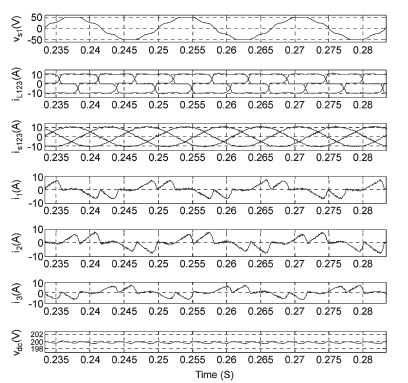ABSTRACT
The
current control of three-phase grid-connected converters is typically carried
out by using a proportional resonant controller or synchronous reference frame
proportional integral regulator. The implementation of these controllers often requires
knowledge of the grid voltage frequency/phase angle, which is typically
provided by a synchronization unit. It implies that dynamics and possible
inaccuracies of the synchronization unit have a considerable impact on the
current controller performance. The aim of this letter is to design an adaptive
current controller by using a conventional synchronous reference frame
phase-locked loop (SRF-PLL). In this way, the current controller and
synchronization part are merged into a single unit, which results in a simpler
and more compact structure. The effectiveness of the proposed controller is
verified using experimental results.
KEYWORDS:
1. Current
control
2. Distributed
generation (DG) systems
3. Phase-locked
loop (PLL)
4. Power
converters
5. Synchronization.
SOFTWARE: MATLAB/SIMULINK
CONTROL
SYSTEM CIRCUIT DIAGRAM:
Fig. 1. Power stage of a
three-phase VSC with the proposed PLL-based controller and a harmonic/imbalance
compensator.
EXPECTED EXPERIMENTAL RESULTS:
Fig.
2. Experimental results for the test 1.
Fig. 3.
Experimental results for the test 2.
Fig. 4.
Experimental results for the test 3.
CONCLUSION
In
this letter, a PLL-based controller for grid-connected converters was proposed.
This controller, which is realized by adding a positive feedback loop to the
conventional SRFPLL, eliminates the need for a dedicated synchronization unit and,
therefore, results in a more compact structure. To enhance the
harmonic/imbalance rejection capability of the suggested controller, multiple
complex integrators tuned at low-order disturbance frequencies is employed. To simplify
the tuning procedure, a simple yet accurate linear model describing the frequency
estimation dynamics of the proposed controller was was verified using some
experimental results. The main contribution of this letter is not the proposed controller.
It is actually demonstrating the possibility of making a frequency-adaptive controller
from a standard PLL. The importance of this contribution will be more evident
when we notice that there are a large number of advanced PLLs which can be
explored for the controller design.
REFERENCES
[1] J.
M. Carrasco, L. G. Franquelo, J. T. Bialasiewicz, E. Galvan, R. C. P. Guisado,
M. A. M. Prats, J. I. Leon, and N. Moreno-Alfonso, “Powerelectronic systems for
the grid integration of renewable energy sources: A survey,” IEEE Trans. Ind.
Electron., vol. 53, no. 4, pp. 1002–1016, Jun. 2006.
[2] F.
Blaabjerg, Z. Chen, and S. B. Kjaer, “Power electronics as efficient interface
in dispersed power generation systems,” IEEE Trans. Power Electron., vol. 19,
no. 5, pp. 1184–1194, Sep. 2004.
[3] B.
K. Bose, “Power electronics and motor drives recent-progress and perspective,”
IEEE Trans. Ind. Electron., vol. 56, no. 2, pp. 581–588, Feb. 2009.
[4] F.
Blaabjerg, R. Teodorescu, M. Liserre, and A. V. Timbus, “Overview of control
and grid synchronization for distributed power generation systems,” IEEE Trans.
Ind. Electron., vol. 53, no. 5, pp. 1398–1409, Oct. 2006.
[5] Q. Zeng and L. Chang, “An advanced SVPWM-based
predictive current controller for three-phase inverters in distributed
generation systems,” IEEE Trans. Ind. Electron., vol. 55, no. 3, pp. 1235–1246,
Mar. 2008.
























